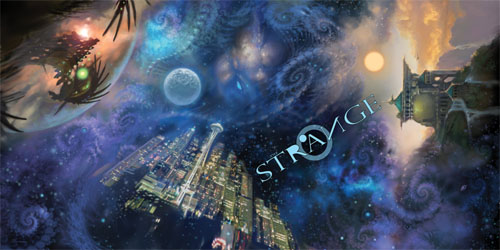Monte Cook’s Numenera has recently been dominating my gaming table: I’ve run twelve sessions of it for three different groups in the last two months and it seems to be a hit with just about everybody. I’ve posted some cool stuff about it recently, so you may already be aware of this.
What you may not be aware of is that Monte Cook and Bruce Cordell have joined forces to create another game using the same engine: The Strange is a multi-dimensional romp in which your characters will change depending on which world they’re currently inhabiting. It’s generally conjuring up images of Torg, Planescape, The Matrix, and the best parts of Amazing Engine. But it also feels like it’s got its own unique little vibe.
They’re currently running a kickstarter for it and I’m mavening for it pretty hard: They’re currently at $351,130 as I write this, but they’ve got a stretch goal at $360k to release an additional 96-page adventure supplement. Since I’m generally a pretty big fan of adventure designed by Cook and Cordell, that’s something I’d really, really like to see happen.
If you’re interested in just taking a peek, you can drop $25 to get PDF copies of the core rulebook and the Player’s Guide. But the real juice starts at $80 (when you get a copy of the rulebook plus PDFs of all seven books that have become part of the kickstarter at this point). There are a bunch of other pledge levels and add-ons, but the next significant plateau for me is the $200 level (where you get printed copies of all seven books). But I’m also going to take a moment to pimp the Superfan packages, which currently look like this (but will continue to improve as more stretch goals are met):
I just recently upgraded my pledge to the $450 MCG Superfan level: It’s getting me 16-18 titles at an average price significantly lower than retail. But, on top of that, I’m also getting the $120 limited edition, the short story collection, decks of cards, and a plethora of pretty awesome goodies.
I’m very, very close to upgrading my pledge by another $200 to get both Superfan packages. I’m not saying it’s something everybody needs to do, but I’m really looking forward to receiving a steady stream of awesome RPG products for the next few years.















How does Strange differ from GURPS? You mentioned its own unique vibe. Is it the same vibe as that of Numenera?
@ Justin,
Glad you’re back.
You’re talking about joining this kickstarter, and it looks like they’re offering lots of swag (handbags, pencils, stickers, etc). Do they break down how they price their needs at $360K? I.e. are they paying the artists most of the money they raise, significant amounts for themselves, or is it mostly going to all the goodies they are offering as swag? They may not list any of that, but you did previously confirm, most game writers are making something like 3 cents a word of print. Does Monte Cook fall into a category like that, or does his fame dramatically increase his paycheck, like it does for famous fantasy artists?
Basically, I’m curious how much it costs to produce a game per page, with quality, but not overpaid/overknown artists, without confusing the issues by offering people handbags, etc. If you’re asking for money up-front, what are your ethical obligations to itemize how much you’re paying yourself and your artists?
In your own experience, did you ever just write your own game supplements and adventures and then sell them after the fact, or was it always under the aegis of an employer-company paying your hours, or a kickstarter-type arrangement before producing the finished product?
The reasons for these questions are since I’m curious about Hobbyist game producers doing it on their own, as opposed to an Industry producer model.
Re: GURPS, you’re a fan of detailed rule systems, do you have any recommendations for that rule system? What’s this Amazing Engine, I’ve heard the name before, and it’s catchy enough to remember?
I notice this latest article says it was from November 21st, and as of yesterday it wasn’t posted. Is the 10 day delay in publishing some problem with wordpress?
I never played GURPS. They took an abstract game mechanic Steve Jackson initially designed for his game books (which I loved), and then set up a universal game mechanics with supplements to run games in specific settings. I started fleshing out set of adventures in their stone-age setting, but it never materialized. BTW, I am a fan of realism not necessarily detail. Of the Aftermath! and Twilight 2000 (1st edition), I ran a better adventure using the Aftermath!, and I didn’t find the rules overly tedious, though I dropped about half the combat rules. The complexity of my current D&D project are the result of about 10 years of modifying AD&D and developing house rules. I took it in the direction of the AD&D last great writing on adventure design, that was in Dungeoneer Survival Guide on story development. AD&D 2nd edition made a whole bunch of adventure design supplements that diverged somehow. The writing felt different to me.
@ Brooser,
I commented on the last article, so go read that, the one about convicts getting 20 year sentences, and Al Capone.
I downloaded some of GURPS medieval combat stuff, and found it interesting in some respects, but not nearly as good as I’d hoped. Overall, it’s overly detailed, without the compensation of being accurate in it’s excessive amounts of details. Which is a pretty pointless exercise and basically a sham as a simulation. Steve Jackson needs to spend 15-20 years in a prison, learning to be a welder. Not serious, but I’ll state that, in case anyone is autistic and doesn’t register these things.
As far as spending 10 years to modify AD&D into a series of house rules, you do realize that Gygax would be ranting at you from that #16, July, 1978 edition of “The Dragon,” as it was then called. His article was: “Role Playing: Realism vs. Game Logic; Spell Points, Vanity Press, and Rip-offs,” Calling your work, a ‘fantasy variant,’ and not really good enough to be his masterpiece, AD&D. From his own words and abuse of players and better designers than himself, you really get to see what a disingenuous, poisonous character that man really was, when there was money to be made by reneging on promises to keep the game open and not constrained by official rulesets. Next, you’ll be saying you use critical hits, which Gygax totally loathed. Not that I think there’s anything wrong with selling modules, I think they’re great, if they’re actually written well, which his weren’t. But, you shouldn’t lie about your motives and you shouldn’t abuse your gamers. And if you do, you deserve to be exposed and castigated for it, so others don’t imitate your abusive example.
I lost interest in most things related to D&D way before 2nd edition. Other systems held more promise, and I kept coming back to the idea of writing something new, of my own. But, the Dungeoneer Survival Guide, does sound interesting, at least as a concept. I’ve tried to look stuff up for it online, and not really found much about its actual contents. What’s in it? How to avoid pit traps, de-set x-bow traps, treat poisonous bites, mapping underground, avoiding giardia in your drinking water, etc?
Fact check: The Steve Jackson who wrote the gamebooks isn’t the same Steve Jackson who designed GURPS and runs Steve Jackson Games.
[…] Check This Out: The Strange – Monte Cook Games […]
Actually he wrote several.
“Jackson is often mistaken for Steve Jackson, a British gamebook and video game writer who co-founded Games Workshop. The confusion is exacerbated by the fact that while the UK Jackson was co-creator of the Fighting Fantasy gamebook series, the US Jackson also wrote three books in this series (Scorpion Swamp, Demons of the Deep, and Robot Commando), and the books did not acknowledge that this was a different ‘Steve Jackson’.”
https://en.wikipedia.org/wiki/Steve_Jackson_(US_game_designer)